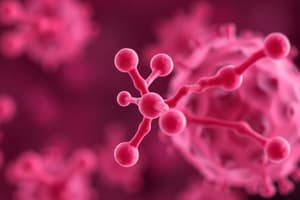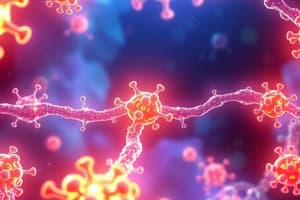Podcast
Questions and Answers
What is the main mechanism of transport for molecules like mAb within a fluid?
What is the main mechanism of transport for molecules like mAb within a fluid?
- Convection
- Convention (correct)
- Endocytosis
- Receptor-mediated transport
What is the difference between phagocytosis and pinocytosis?
What is the difference between phagocytosis and pinocytosis?
- Phagocytosis occurs in cells, while pinocytosis occurs in tissues
- Phagocytosis is the internalization of liquid phase molecules, while pinocytosis is the internalization of solid material
- Phagocytosis is fast, while pinocytosis is slow
- Phagocytosis is the internalization of solid material, while pinocytosis is the internalization of liquid phase molecules (correct)
How do mAb preferentially bind to antigens?
How do mAb preferentially bind to antigens?
- Non-specifically through the Fc portion to soluble antigens
- Non-specifically through the Fc portion to cell surface antigens
- Specifically through the Fab portion to soluble antigens (correct)
- Specifically through the Fab portion to cell surface antigens
How are mAb eliminated from the body?
How are mAb eliminated from the body?
Which type of mAb is degraded the fastest?
Which type of mAb is degraded the fastest?
What determines the binding of mAb to antigens?
What determines the binding of mAb to antigens?
What is the role of the Fc receptor in mAb?
What is the role of the Fc receptor in mAb?
What is the consequence of high competition between mAb and the endogenous antigen ligand?
What is the consequence of high competition between mAb and the endogenous antigen ligand?
What is the difference in the degradation rate between human and murine mAb?
What is the difference in the degradation rate between human and murine mAb?
What is the key factor in the binding of mAb to antigens?
What is the key factor in the binding of mAb to antigens?
Study Notes
Complement-Dependent Cytotoxicity and Antibody Functions
- Complement-dependent cytotoxicity (CDC) involves recognition of the Fc portion of antibodies, independent of specific antigen recognition.
- Antibodies neutralize exotoxins and viruses by targeting specific structures on microorganisms.
- Preventing bacterial adherence to host cells is a crucial antibody function.
- The membrane attack complex (MAC) leads to cytolysis, facilitating cell destruction.
- Agglutination is a process by which antibodies clump microorganisms together, enhancing their clearance.
- Immobilization of bacteria and protozoa occurs through specific antibody binding.
- Opsonization enhances phagocytosis by marking pathogens for destruction.
Strategies for Targeting Tumor Cells
- Naked antibodies can target tumor cells or be combined with radioactive ligands via streptavidin or bispecific antibodies.
- Bispecific antibodies can simultaneously bind tumor cells and immune cells, enhancing the immune response.
- Simple chain variable fragments (scFvs) can be linked to liposomes that deliver drugs or enzymes for localized treatment.
- Antibody-directed enzyme prodrug therapy (ADEPT) utilizes enzymes to convert prodrugs into active chemotherapeutics at tumor sites.
- Potelligent technology enhances antibody efficacy by removing fucose, increasing binding affinity to FcγRIIIa (CD16), leading to improved antibody-dependent cellular cytotoxicity (ADCC).
Clinical Implications and Efficacy
- Potelligent-enhanced antibodies are expected to show superior efficacy and safety in human patients.
- Increased Fc receptor binding improves clinical responses and reduces the necessary therapeutic doses.
- Antibody therapies are typically employed when the patient's immune system is intact, targeting cancer or pathogens.
Transport and Binding Mechanisms
- Antibodies travel through fluids, utilizing conventional transport methods and endocytosis (both receptor-mediated and non-receptor-mediated).
- Specific binding occurs via the Fab portion of the antibody, while non-specific binding occurs through the Fc portion.
- Antibodies favor binding to soluble antigens; competition exists when antigens are accessible in both soluble and cell-surface forms.
Antibody Elimination and Stability
- Antibodies face degradation through proteolysis, with Fc receptors providing protection against rapid catabolism, ensuring longer half-lives.
- The stability of monoclonal antibodies (mAbs) varies: murine mAbs degrade quickly, while humanized mAbs have a longer lifespan (murine < chimeric < humanized < human).
Studying That Suits You
Use AI to generate personalized quizzes and flashcards to suit your learning preferences.
Related Documents
Description
This quiz covers the various functions of antibodies, including complement-dependent cytotoxicity, neutralization of exotoxins and viruses, prevention of bacterial adherence to host cells, and membrane attack complex formation.




